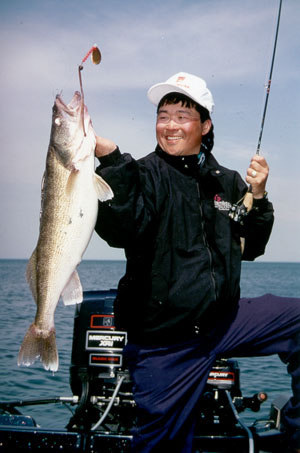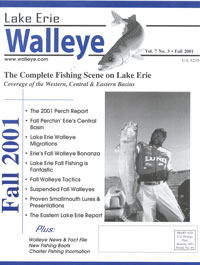oo bad for the fair-weather fishermen who have already
put their boats away. Some of the best fishing of the year is just ahead. The
shorter days and cooler water of late fall mean gamefish, like walleyes, go on a
last feeding binge before freeze up when their metabolism slows for winter. Feeding fish are vulnerable fish. As a
result, late fall can be the best time of the year to catch a trophy.
their metabolism slows for winter. Feeding fish are vulnerable fish. As a
result, late fall can be the best time of the year to catch a trophy.
Walleyes begin moving to deep-water structure as the water cools down. Fish
can be as far down as 25 to 50 feet or more on the steep, hard-bottom drop-offs
next to points, humps and islands. Often, they can be found on the
spots-on-a-spot that are the sharpest breaks nearest the deepest water
available.
As always, start with the fastest tactic that works to nab active walleyes.
Donít rule out trolling crankbaits as a tactic even though water is cold.
Trolling is still the best way to cover water fast to locate active pods of
fish. Tournament anglers have shown time and time again it works even when itís
cold enough to snow. Once a school is located, rig or jig to catch even more
fish that may be in a neutral mood at the time.
Cold-water
precisely.
Crankbaits are in the strike zone more as a result, and that equals more fish.
In addition, cranks behind leadcore have a more subtle action, which works
better in cold water than snap weights.
Start with a longer, medium-action rod to help absorb some of the shock of a
strike on no-stretch, leadcore. Use 18-pound test leadcore line. Strip the
Dacron back from the lead core middle and tie on a small #12 barrel swivel. Add
an 8 to 10 foot leader of 10 to 12 pound monofilament, like Strenís Super
Tough. Some people prefer to use no-stretch braided line for the leader. But, if
you do that, make certain you set your drag very loosely. Fish can tear free
from hooks if you donít allow some "give" in your tackle somewhere.
Tie on a snap or ball-bearing snap swivel and you are set to go.
Ask at local bait shops to find areas of the lake that are producing. Donít
be surprised if the best locations are in deep water near the mouths of feeder
rivers and creeks that the walleyes will migrate up to spawn in spring.
Check the lake map for sharper drop-offs at the right depth that are likely
to produce. Travel to one, and chart the break by following the contour and
graphing it on your GPS. Or, drop marker buoys on the fingers extending from the
structure and the inside turns were fish might lurk. Look for schools of
baitfish and even larger marks that might signal walleyes below. Use an Aqua-Vu
fish cam to confirm the presence of walleyes.
Try a variety of lures to start. Bomber 24Aís are a good start. Shad Raps
and Lindy Shadlings are likely to produce. Try Thundersticks if you have them.
Remember, itís the leadcore that takes the crankbait to the bottom, not the
crankbaitís design. That means you can use anything you think might work, and
that even includes shallow running floaters.
Stick with subtle wobblers in colder water instead of the more erratic ones.
Keep in mind, larger profiled lures may be best because baitfish have grown
bigger by this time and the fish are looking to fatten up for the winter. Use
metallic colors for bright sunny days. Try bright, fluorescent colors like
firetiger and chartreuse for dingy water. Change up often until you find
something that works.
When you are ready, go to the beginning of the trolling pass you have laid
out, lower the bait so it travels just off the bottom and use the gasoline
kicker motor to move slowly ahead, 1.5- to 2 mph. Vary the speed to see what the
fish want. But, remember, leadcore has greater water resistance than
monofilament. The faster you go, the higher the bait rises. The slower you go,
the deeper it dives. Stay in the strike zone as you follow the shape of the
breakline as precisely as you can. Watch the end of your rod tip. Check your
bait for hooks fouled with debris when you see the tip stop vibrating.
Mark the location with your GPS when you connect with active walleyes. Stay
with the trolling tactic as long as it works. Youíll cover more water and
catch more fish by concentrating on the active ones. When the action slows down,
change tactics by slowing down your presentation by resorting to Lindy rigging
or jigging.
Rigging for fall
Livebait often works when nothing else will do. Lindy rigs or NO-SNAGG rigs
are the most natural way to reach deep fish.

 their metabolism slows for winter. Feeding fish are vulnerable fish. As a
result, late fall can be the best time of the year to catch a trophy.
their metabolism slows for winter. Feeding fish are vulnerable fish. As a
result, late fall can be the best time of the year to catch a trophy.